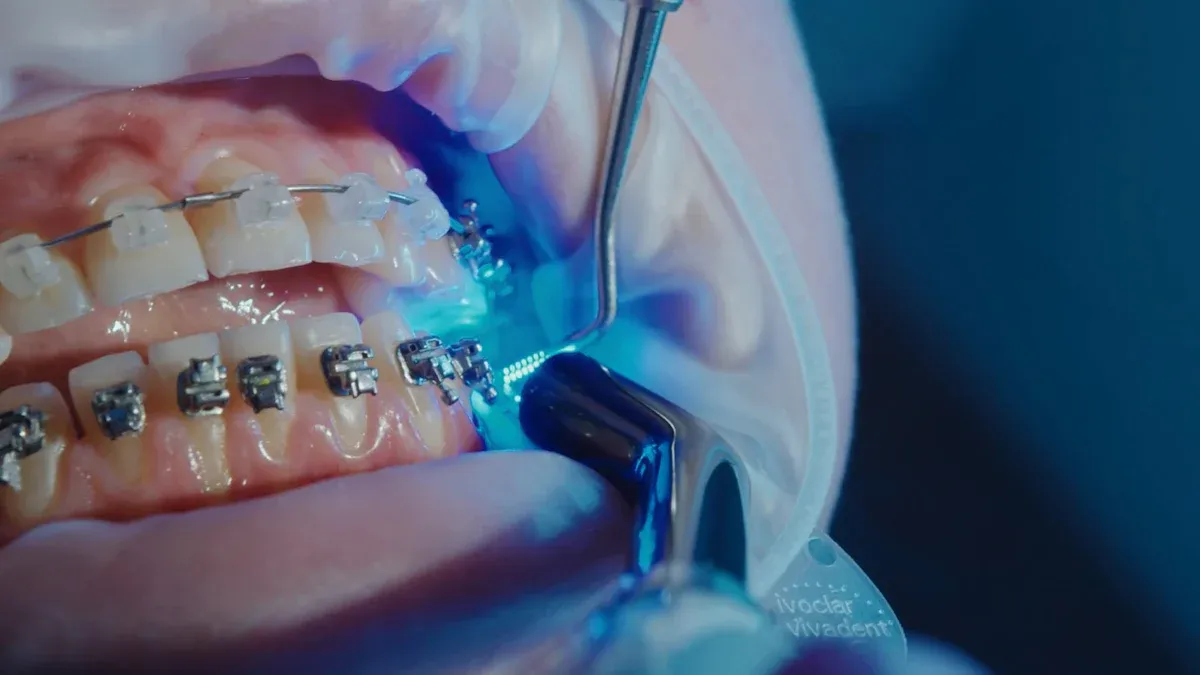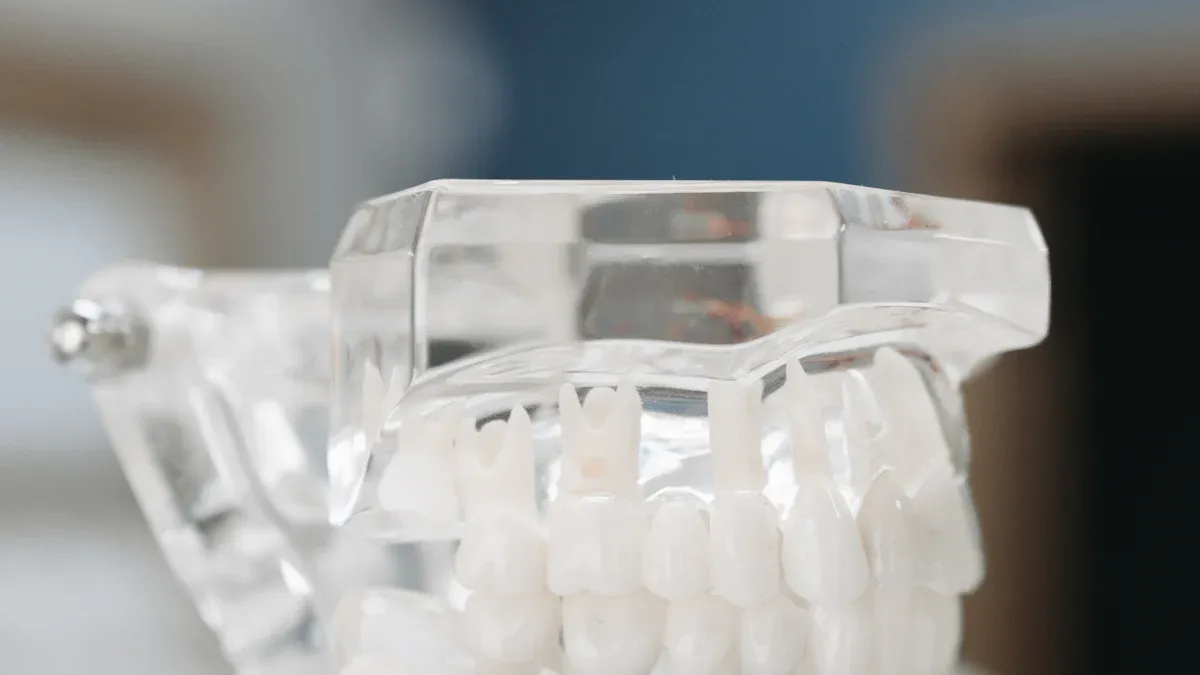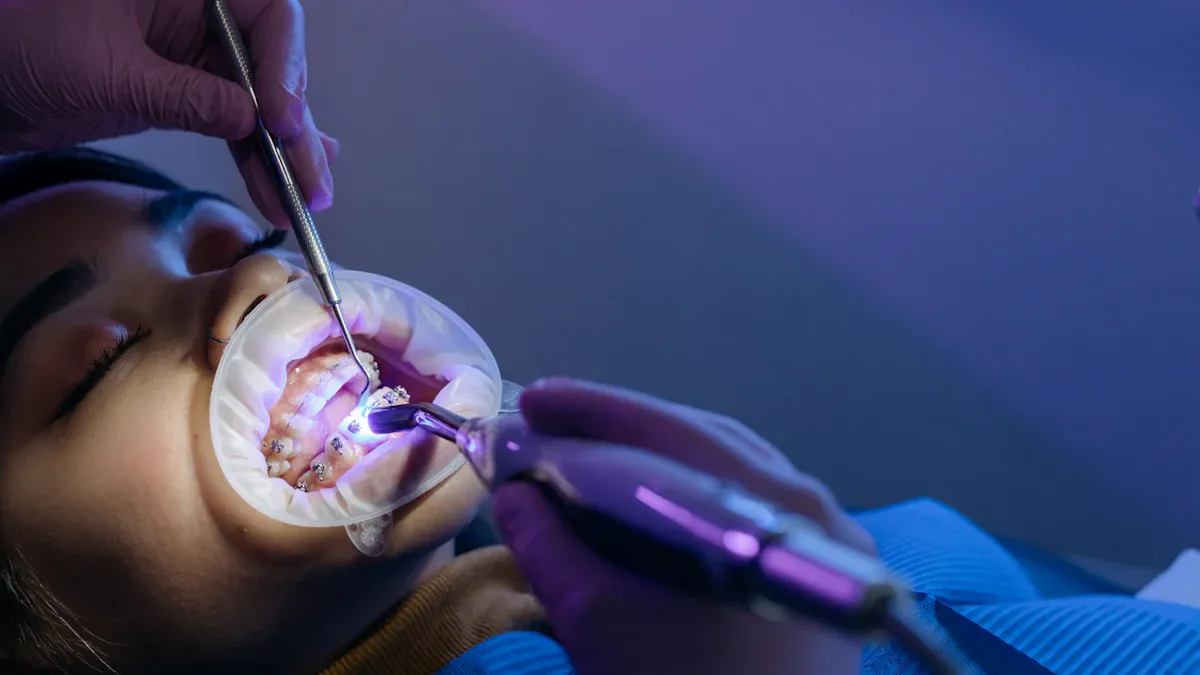What Makes Orthodontic Spring Nitinol Tubing Essential in Braces

Orthodontic spring nitinol tubing is very important in braces. It helps move teeth with a steady and gentle force. This tubing is made from a nickel-titanium alloy. It is special in orthodontics because it is superelastic and has shape memory. These features help nitinol tubing adjust as teeth move. This gives more comfort and fewer changes for patients. Other materials do not keep their shape as well. Orthodontic spring nitinol tubing stays the same and gives steady results during treatment. Studies show nitinol tubing moves teeth faster, especially in the lower arch. You can see this in the chart below.
Nitinol tubing gives a constant force. This means patients need fewer changes and feel less pain during treatment.
Key Takeaways
Nitinol tubing in braces is made from a special metal. This metal is a nickel-titanium alloy. It can bend and then go back to its shape. It gives a gentle and steady force. This helps move teeth in a comfortable way.
Its superelasticity and shape memory help teeth move faster. It also causes less pain for patients. This means fewer visits to the orthodontist. It also means fewer adjustments are needed.
Nitinol tubing is very strong and lasts a long time. It does not rust or get damaged easily. This makes braces more reliable. It also makes them easier to wear.
Nitinol tubing is better than stainless steel in some ways. It is more flexible and comfortable. It gives a steady force. This makes it great for early and middle treatment stages.
Orthodontists use nitinol tubing in springs and wires. These help move teeth smoothly. This helps patients get straighter teeth with fewer problems.
Orthodontic Spring Nitinol Tubing

What Is Nitinol Tubing?
Orthodontic spring nitinol tubing is very important in today’s braces. This tubing is made from a mix of nickel and titanium. It usually has about 55% nickel and 45% titanium. Companies make sure the tubing is safe by following strict rules like ASTM F2063. These rules check for things like strength, stretching, and how it reacts to heat. Nitinol tubing is strong and safe for use in the mouth. Tests show it is safe to use for a long time. Special surface treatments, like electropolishing, help stop rust and make it even safer.
Nitinol tubing can go back to its original shape after bending. This is called shape memory. It happens because the inside structure can change and then switch back. The tubing can bend or stretch and then return to normal when warmed or let go. This makes orthodontic spring nitinol tubing great for braces. It helps move teeth gently and in a controlled way.
Note: Nitinol tubing keeps its shape and strength for a long time. This helps teeth move as planned and lowers problems during treatment.
Key Properties
Nitinol tubing has many special features that make it important in orthodontics. The main ones are superelasticity, shape memory, fatigue resistance, and biocompatibility. These features make nitinol tubing better than older materials.
Property/Test Type | Key Findings and Implications for Orthodontics |
|---|---|
Superelasticity | Nitinol tubing can bend or stretch a lot and still go back to its shape. This lets it give a gentle, steady force over a big range of tooth movement. |
Fatigue Resistance | It can handle millions of bends and stretches without getting weak. This means it lasts a long time in braces. |
Force Consistency | It keeps almost the same force when squeezed or let go. Other metals get stronger when bent, but nitinol tubing does not. This helps patients feel less pain. |
Clinical Success Rate | Studies show nitinol tubing works well in 97% of cases and helps 83% of patients finish treatment with fewer changes and more comfort. |
Biocompatibility and Corrosion Resistance | Nitinol tubing does not rust and causes less irritation than stainless steel. This makes it safer to use in the mouth. |
Mechanical Testing | Bending tests show it can turn from 0° to 180° without breaking. It can stretch up to 12% before snapping, so it is very tough. |
Temperature Effects | The force changes with temperature, but it works best at body heat. It keeps its shape memory and steady force in the mouth. |
Clinical Benefits | Patients need fewer changes, feel less pain, and teeth move more as planned compared to stainless steel wires. |
Superelastic nitinol tubes can bend or stretch much more than regular metals. They still go back to their original shape. This lets orthodontic spring nitinol tubing give a gentle, steady force for many tooth movements. The tubing’s shape memory means it can return to its shape when warmed by the body. This helps the tubing keep working well during treatment.
Nitinol tubing is also very tough. It can bend and stretch many times without losing strength. This is important because braces stay in the mouth for a long time. The tubing is safe for the mouth because it does not rust. A layer of titanium oxide on the tubing stops nickel from leaking out. This lowers the chance of allergies or sore gums. This makes nitinol tubing safe for braces.
Superelastic nitinol tubes can also take in shocks better than stainless steel wires. This helps protect teeth and gums when chewing. The tubing’s superelastic and shape memory features work together. They give a gentle, steady force and help lower pain for patients.
Nitinol tubing can change between two forms called austenite and martensite. This gives it superelasticity and shape memory. These changes happen near body temperature, so the tubing works well in the mouth. Superelastic nitinol tubes keep working even if the mouth gets warmer or cooler. This lets orthodontists pick tubing that works best for each patient.
Tip: Orthodontic spring nitinol tubing gives the softest and most steady force of all common orthodontic wires. This makes it a great choice for early tooth straightening.
Uses in Braces
Nitinol Springs and Coils
Orthodontists use nitinol tubing in many kinds of springs and coils. These include open-coil springs, closed-coil springs, and push or extension springs. Each spring type helps teeth move in different ways. Open-coil springs use nitinol tubing to make space between teeth. Closed-coil springs help close gaps after teeth are pulled out. Push or extension springs use the tubing to move teeth forward or backward.
Nitinol tubing is special because it can bend and stretch but still keep its shape. This makes it great for springs that need to last a long time. The tubing’s superelasticity and shape memory let it give a steady orthodontic force. This force stays almost the same even as teeth move.
A study looked at how orthodontists use nitinol closed-coil springs to close spaces in the upper jaw. The springs went from the first molar hook to the canine hook. The study compared these springs to active tie-backs on the other side of the mouth. Nitinol springs gave a more steady force, which helped teeth move more smoothly. The study also found that nitinol tubing springs had more germs build up, so patients must keep their mouths clean. Still, orthodontists like nitinol tubing because it gives steady force and moves teeth well.
The table below shows how superelastic and shape memory nitinol tubing are used in orthodontic springs:
Property / Feature | Superelastic Nitinol Tubing | Shape Memory Nitinol Tubing |
|---|---|---|
Activation Mechanism | Stress-induced phase change | Temperature-induced phase change |
Shape Recovery | Immediate upon unloading (no heat needed) | Delayed, requires heating |
Typical Strain Limit | Up to ~4% strain at body temperature | Up to ~8% strain after heating |
Fatigue Resistance | Very high, suitable for repeated bending cycles | High, but depends on cycling and heating |
Clinical Application Examples | Orthodontic wires, stents, guidewires | Actuators, surgical tools needing heat activation |
Mechanical Behavior | Maintains superelasticity under cyclic loading | Shape fixed until heated, then recovers shape |
Superelastic nitinol tubing is the best choice for orthodontic springs. It works well for lots of bending and gives a steady orthodontic force. Shape memory tubing is better for tools that need heat to change shape.
Tip: Nitinol tubing springs help orthodontists move teeth with less pain and fewer visits for changes.
How Nitinol Tubing Moves Teeth
Nitinol tubing moves teeth because of its superelastic and shape memory features. The tubing changes between two forms called martensite and austenite. This lets the tubing bend and stretch, then go back to its shape. The tubing gives a steady orthodontic force over a big range of tooth movement. This force stays gentle and almost the same, even as teeth move.
Nitinol tubing’s superelasticity and shape memory come from changes in its crystal structure. This lets the tubing bend and snap back to shape.
The tubing gives a steady orthodontic force, which helps teeth move in a controlled way.
Tests show nitinol tubing gives a constant force, making tooth movement more comfortable and effective.
The tubing’s flexibility and toughness lower the chance of irritation and mean fewer changes are needed.
Studies show nitinol tubing helps teeth line up faster, safer, and with more comfort.
Nitinol tubing is used in many ways in the clinic. Orthodontists use it in archwire springs to open or close spaces between teeth. They also use it to line up teeth after extractions or fix crowding. The tubing’s steady orthodontic force helps teeth move well. Tests show both superelastic and heat-activated nitinol archwires move teeth at about the same speed. The difference is in how each type gives force. Superelastic nitinol gives a quick, steady force, while heat-activated tubing uses body heat to start movement.
Orthodontists pick nitinol tubing because it is flexible, strong, and keeps working for a long time. The tubing helps teeth move as planned, with fewer office visits and less pain. This makes nitinol tubing very important in today’s braces and answers the question, "how is nitinol wire used in braces?"
Note: Nitinol tubing helps teeth move well by giving a gentle, steady orthodontic force. This helps patients get straighter teeth with less pain and fewer changes.
Benefits of Nitinol Tubing
Comfort and Fewer Adjustments
Nitinol tubing makes braces more comfortable for patients. People feel less pain and less irritation when their teeth move. The tubing uses a gentle and steady force to shift teeth. This helps teeth move smoothly and slowly. Many people say nitinol tubing feels better than regular wires. Superelastic nitinol tubing bends easily and goes back to its shape. It does not poke or hurt the gums or cheeks.
Nitinol tubing puts gentle pressure on teeth all the time. This makes moving teeth easier and less painful than stainless steel wires.
Copper NiTi heat-activated tubing gets soft with body heat. It then gives gentle force and lowers pain during changes.
The smooth surface of nitinol tubing stops gums and cheeks from getting sore.
Patients with nitinol tubing need fewer changes and feel less pain during treatment.
A study showed that nitinol tubing helped teeth line up 30% faster in six months. This was compared to stainless steel wires. Nitinol tubing keeps its force for a long time. Orthodontists do not need to make as many changes. This makes treatment easier for both patients and doctors.
Patients feel more relaxed with nitinol tubing. It gives steady results and means fewer trips to the orthodontist.
Durability and Effectiveness
Nitinol tubing is strong and works well to move teeth. It does not bend or break easily, even after lots of use. This means nitinol tubing keeps working for the whole treatment. Its superelasticity helps it keep giving a steady force. This helps teeth move the right way.
Nitinol tubing lasts longer than many other materials used in braces.
Its steady force helps teeth move well and line up better.
Studies show nitinol tubing helps patients finish treatment with fewer visits.
Its long life and fewer changes make it a good choice for families.
Nitinol tubing helps teeth move as planned and gives good results. Orthodontists trust it because it works well and gives great outcomes.
Nitinol vs. Stainless Steel

Nitinol Wire Advantages
Nitinol tubing and nitinol wire have changed braces. These materials can bend and stretch a lot. They do not lose their shape. Nitinol tubing can stretch up to 8% and still go back. This helps archwires give a gentle, steady force. Patients feel less pain and teeth move faster with nitinol archwires.
Nitinol tubing bends and goes back to its shape.
Nitinol wire keeps tension, so fewer changes are needed.
Nitinol archwires use body heat to help teeth move.
Nitinol tubing does not rust and lasts longer.
Nitinol wire is light and not bulky, so it feels better.
Nitinol tubing can bend many times and does not break easily.
Studies show nitinol tubing makes teeth move with less pain. Its flexibility helps archwires fit many mouths. This makes nitinol wire a good choice for early treatment.
Traditional Materials Compared
Stainless steel tubing and wires have been used for years. They are strong and help control teeth at the end of treatment. But stainless steel does not have superelasticity or shape memory. This changes how archwires work.
Property/Metric | Nitinol Tubing Characteristics | Stainless Steel Tubing Characteristics |
|---|---|---|
Flexibility | High flexibility helps it fit tricky spaces | Not very flexible, so it is harder to use in tight spots |
Shape Memory Effect | Can bend and return to shape | Stays stiff and does not return to shape |
Fatigue Resistance | Can bend many times without breaking | Breaks sooner after many bends |
Corrosion Resistance | Does not rust easily, even with special coatings | Rusts more than nitinol |
Patient Comfort | Makes braces more comfortable and lowers problems | Can feel stiff and cause more pain |
Clinical Outcomes | Works well and breaks less often | Does not last as long and can break more |
Nitinol tubing and wire give a gentle, steady force. This helps teeth move with less pain and fewer visits. Stainless steel tubing is strong but can feel stiff and hurt more. Nitinol tubing is best for the start and middle of treatment. Stainless steel tubing is good for the end when more control is needed.
Orthodontists use both materials. Nitinol tubing starts with comfort and flexibility. Stainless steel tubing finishes with strength and control. This helps patients get the best results.
Nitinol tubing is very important in today’s braces. It gives a steady force to move teeth. This helps teeth move with less pain. Patients do not need as many changes. The tubing keeps its shape and stays strong. This makes treatment easier for people. Many orthodontists pick this tubing because it lasts longer. It also works better than old wires. The tubing makes braces more comfortable. People need fewer trips to the orthodontist. Patients should talk to their orthodontist about tubing choices. New tubing keeps making orthodontic care better.
FAQ
What makes orthodontic spring nitinol tubing different from regular wires?
Orthodontic spring nitinol tubing can stretch and return to shape. It uses superelastic behavior and shape memory. These features help it give a steady force on teeth. Regular wires do not have these special abilities. Nitinol tubing helps teeth move well with less pain and fewer changes.
How does nitinol tubing help with effective tooth movement?
Nitinol tubing gives a steady force on teeth. This gentle force moves teeth slowly and safely. The tubing’s shape memory helps teeth line up better. Orthodontists see good results and safer treatments with this tubing.
Why do orthodontists prefer nitinol wire for braces?
Nitinol wire bends and goes back to its shape. Superelastic nitinol tubes last longer and do not break much. Nitinol archwires use body heat to help teeth move. These features make braces more comfortable and need fewer changes.
Is nitinol tubing safe for everyone?
Nitinol tubing is safe for most people. Studies show it does not rust and causes less soreness. Its safety makes it a good choice for braces. Patients should tell their orthodontist if they have metal allergies.
How is nitinol wire used in braces?
Orthodontists use nitinol wire in archwires and springs. The wire’s superelastic and shape memory help teeth move into place. Nitinol tubing and wire give a steady force, making tooth movement easier and more comfortable.
See Also
The Importance Of Nitinol Tubing In Minimally Invasive Surgery
Nitinol Tubing’s Critical Role In Cutting-Edge Medical Uses
The Process Behind Manufacturing Nitinol Tubing For Medicine
A Deep Dive Into Nitinol Tubing Uses In Medical Devices
Ways Nitinol Tubing Is Transforming Modern Medical Technology

